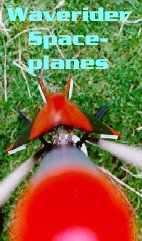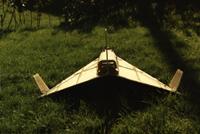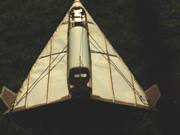
The Mark 6 Waverider
The Mark 6 waverider was the Tiger Rocket-boosted Remotely Piloted Vehicle. It was in effect an early Mark 7 waverider flying testbed designed to cruise at Mach 4. In its original form, it never flew, although a full scale mock-up of the Tiger Rocket/Waverider stack was constructed. The exercise was a valuable learning experience.


The photographs above refer to the follow-on to the basic Mark 6. The concept was mooted of building a flying Radio-controlled testbed of the all-moving tip-fins concept, wherein the whole tip-fin rotated on a central axle Normal to the upper wing surface, and so with two tip-fins in operation, the functions of elevator and aileron could be mechanically mixed together.
A vehicle was quickly knocked-up by Rick Newlands, based on the Mark 6 design, to iron out the stability bugs before commencing construction of something more expensive and build-time-consuming.
The vehicle is shown with its covering off, but once a tail-unit and fixed, upswept elevons were added, this vehicle was very stable, and was flown several times before its flimsy structure got soggy, gliding in typical Scottish weather conditions, and disintegrated.
It had served its purpose well though, by proving that the concept was sound.
The Tiger Rocket
Tiger was a British LOx/Kerosene sounding-rocket designed by Rocket Services, and used to boost the Mark 6 waverider up to Mach 4 on a level trajectory from a 30 km apogee, at which point, the Mark 6 waverider would separate, and glide in a 200 kilometre radius circle around the Scottish Isle of St Kilda radar tracking station, decelerating from Mach 4 to low subsonic speeds, at which point, a landing approach would be simulated at some altitude, then a recovery parachute and flotation device and marker dye would be deployed.
Attitude, pressure and maximum temperature data would be telemetered to the ground via the onboard flight computer.





